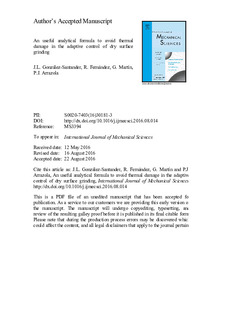Title
A useful analytical formula to avoid thermal damage in the adaptive control of dry surface grindingOther institutions
Universidad Católica de ValenciaVersion
Postprint
Rights
© 2016 Elsevier Ltd. All rights reserved.Access
Open accessPublisher’s version
https://doi.org/10.1016/j.ijmecsci.2016.08.014Published at
International Journal of Mechanical Sciences Vol. 117. Pp. 152–161. October, 2016xmlui.dri2xhtml.METS-1.0.item-publicationfirstpage
152xmlui.dri2xhtml.METS-1.0.item-publicationlastpage
161Publisher
ElsevierAbstract
An adaptive control is proposed for dry surface grinding to extend the use of the wheel without needing to be dressed, preserving at the same time the surface integrity of the workpiece. The implement ... [+]
An adaptive control is proposed for dry surface grinding to extend the use of the wheel without needing to be dressed, preserving at the same time the surface integrity of the workpiece. The implementation of this adaptive control needs to use predictive models of thermal damage, as in the case of Malkin's model, which calculates the allowable grinding power before the workpiece gets burnt for any working condition. In this latter case, the adaptive control of the cutting depth condition requires solving a quartic equation. Since the analytical procedures for solving quartics given in the literature are quite cumbersome to implement in the numeric control of the grinding machine, we propose a closed analytic formula in order to compute directly the unique positive solution. Moreover, we can enhance Malkin's model in order to consider an arbitrary heat flux profile entering into the workpiece and the kinematical correction to the geometrical contact length, in such a way that we can still using the latter solution to the quartic equation. [-]
Collections
- Articles - Engineering [743]





















